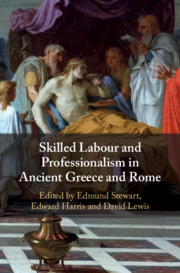Book contents
- Skilled Labour and Professionalism in Ancient Greece and Rome
- Skilled Labour and Professionalism in Ancient Greece and Rome
- Copyright page
- Contents
- Illustrations
- Contributors
- Acknowledgements
- Abbreviations
- Introduction
- Part I Professionals and Professional Identity in Greece and Rome
- Part II Specialization and the Division of Labour in the Ancient City
- Part III Case Studies of Professions 1: Sculpture
- 6 Professionalism in Archaic and Classical Sculpture in Athens: The Price of Technē
- 7 Artists beyond Athens: The Freedoms and Restrictions of the Artistic Profession in Classical Greece
- 8 Roman Sculptors at Work: Professional Practitioners?
- Part IV Case Studies of Professions 2: Music and Athletics
- Part V Case Studies of Professions 3: A Profession of Arms?
- Index
- References
6 - Professionalism in Archaic and Classical Sculpture in Athens: The Price of Technē
from Part III - Case Studies of Professions 1: Sculpture
Published online by Cambridge University Press: 18 September 2020
- Skilled Labour and Professionalism in Ancient Greece and Rome
- Skilled Labour and Professionalism in Ancient Greece and Rome
- Copyright page
- Contents
- Illustrations
- Contributors
- Acknowledgements
- Abbreviations
- Introduction
- Part I Professionals and Professional Identity in Greece and Rome
- Part II Specialization and the Division of Labour in the Ancient City
- Part III Case Studies of Professions 1: Sculpture
- 6 Professionalism in Archaic and Classical Sculpture in Athens: The Price of Technē
- 7 Artists beyond Athens: The Freedoms and Restrictions of the Artistic Profession in Classical Greece
- 8 Roman Sculptors at Work: Professional Practitioners?
- Part IV Case Studies of Professions 2: Music and Athletics
- Part V Case Studies of Professions 3: A Profession of Arms?
- Index
- References
Summary
The common perception of craftsmen in Classical Athens as banausoi who were looked down on by elite circles in society has become more nuanced over recent years. This chapter contributes to this discussion by investigating the range of social positions in evidence for ancient sculptors. Using theories of professionalism and the aspects of need, demand and reward for sculpture, it argues that in terms of economic rewards as well as social capital, sculptors in Classical Athens were rather well off. As such the negative connotations of banausoi are unlikely to match the realities of ancient Athenian life.
- Type
- Chapter
- Information
- Skilled Labour and Professionalism in Ancient Greece and Rome , pp. 205 - 229Publisher: Cambridge University PressPrint publication year: 2020
References
- 3
- Cited by

